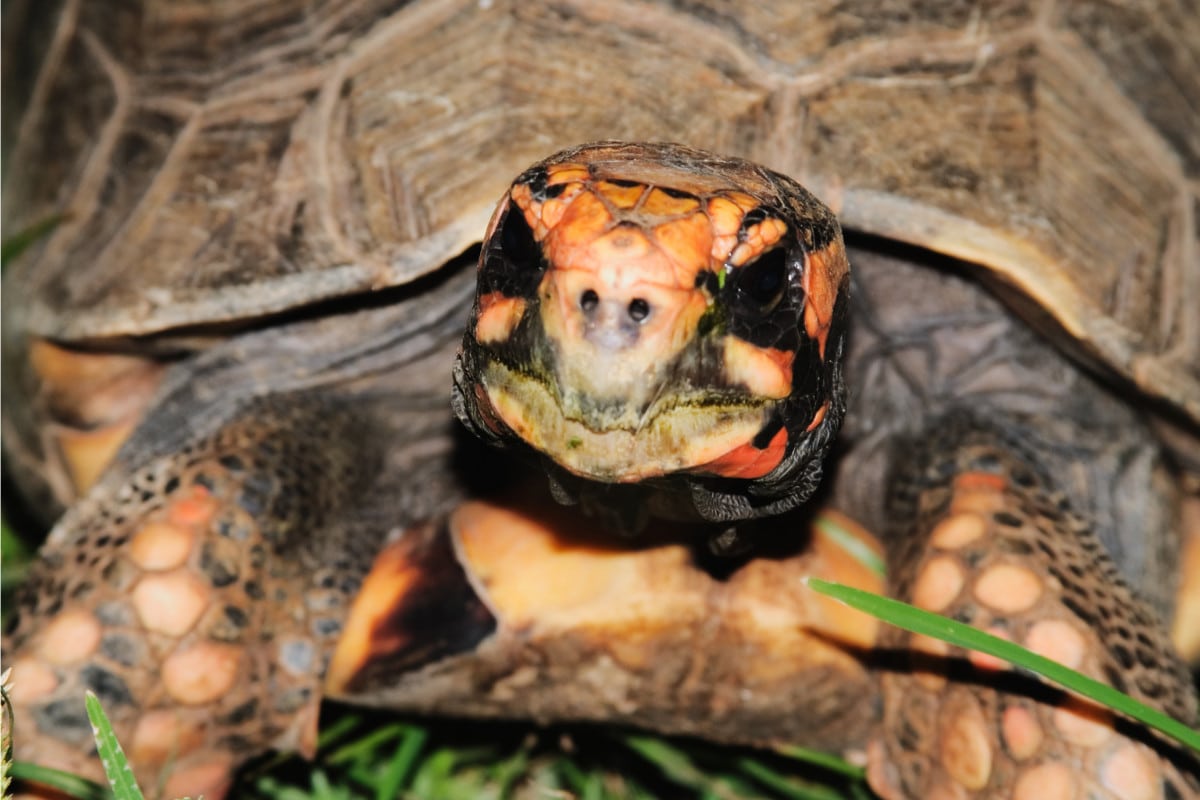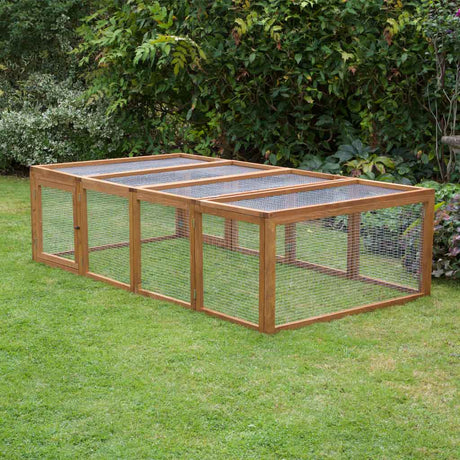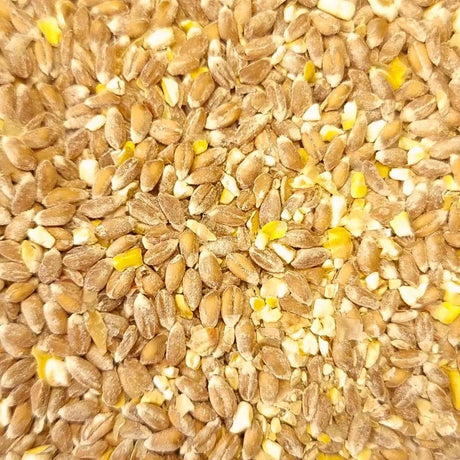With their colourful markings and sociable nature, red footed tortoises make popular pets. Their natural habitat in the forests of South America is quite different to that of many other pet tortoises, so naturally, they have different care needs that we need to understand.
Although they are relatively easy tortoises to care for, like other tortoise species, buying a red-footed tortoise means a lifetime commitment as well as an investment into making sure you have the correct setup to be able to provide for them.
To get started, you will need to know everything you can about red-footed tortoises, from where they are found in the wild, to the optimum basking temperature and substrate.

Red Footed Tortiose Fact File
How do we know how to care for tortoises in captivity? By studying them in their natural environment, of course! The wild is an optimum environment for them to survive therefore it makes sense to take those conditions and replicate them in captivity to ensure our pet tortoises live long and healthy lives!
Common Name
The red-footed tortoise (Chelonoidis carbonarius) is also commonly known as the redfoot tortoise, redleg tortoise or the Savannah tortoise. Of course, their name refers to their distinctive appearance and red feet!
Lifespan
Red-footed tortoises can easily live up to 50 years of age, with many individuals living for many years more than this.
Description
Red footed tortoises get their name from the distinguishable red markings on their legs and head, however these markings can also be orange and yellowish in colour, too!. Their shell is dark brown in colour but sometimes appears black, and has a golden yellow spot on the centre of each scute.
These medium sized tortoises can grow between 11-14 inches in length, with males often growing larger than females. You can also tell males apart as they have a much longer and thicker tail, and their shell is more concave in shape.

Habitat
These tortoises are found in the grasslands and forests of central and south America, from Bolivia to Argentina to Brazil. They favour habitats with higher humidity and dense forest cover and are rarely found in areas that are muddy as it makes it significantly harder for them to burrow.
Behaviours
Red-footed tortoises do not travel as far as some other tortoise species and will rest for around 50% of the daylight hours - they’ll rest even longer after a long meal and come sometimes be found resting for five to ten days! The hours that they are awake they can be found foraging for food and burrowing.
They burrow a lot! These tortoises will burrow to cool down, to seek shelter, and to hide from predators. Unlike other tortoises, red foots will share burrows with other individuals and seem to feel most secure when they are wedged into a small space with others.
They can also often be seen sharing food with other red footed tortoises and gathering in small groups; they aren’t very territorial about feeding or nesting sites.
Reproduction
The only time a red-footed tortoise is likely to show aggression to another tortoise is when two males are competing for a mate. Males will display head bobbing and will wrestle with one another, trying to flip their competition to win a mate.
They will make different sounds and calls and will move their throat in a distinct way to both attract mates and ward off their competition. As these tortoises live in a very warm climate and do not hibernate, mating can occur all year round but will peak in April and May.
Females lay their eggs in leaf litter and do their best to find a spot that will be protected from predators. They do not stay around to incubate them or protect their nest as they can lay several clutches throughout the year.
When young red footed tortoises leave the nest they are completely independent and will begin searching for food and shelter.
Conservation Status
Wild populations of red footed tortoises have not been evaluated however their numbers are thought to be declining in much of their range.
Threats
In many parts of their geographic range the red-footed tortoise is considered a delicacy and is hunted and eaten. They are also taken from the wild for the illegal pet trade and are shipped all around the world. This is also thanks to the fact that they can go long periods of time without food or water, meaning it is very easy to transport them further.
Unfortunately, they are also impacted by huge amounts of habitat loss as the forest is often destroyed to make room for houses in favourable tourist locations.
Keeping a Red-Footed Tortoise as a Pet
Of course, knowing about their natural habitat is just the first step to providing a suitable enclosure for a healthy tortoise. Different tortoise species have different needs and the red-footed tortoise, being from a slightly different habitat to many of the most popular Mediterranean pet tortoises, varies slightly more than other pet tortoises.
Enclosure Size
Firstly, you need to provide them with a large enclosure with ample space. Although they are not known to travel too far, they still need enough space to fulfil all of their natural behaviours; a bored tortoise can easily become stressed and sick.
The enclosure size of a red-footed tortoise should be around 4ft by 8ft however we always recommend more if possible! Due to their larger size when fully grown, a tortoise table may not be appropriate but younger tortoises would do well in one for the first few years of their lives. Many dedicated tortoise owners will even provide a whole room for their red-footed tortoises.
They are also avid burrowers so any enclosure will need to have a sturdy base which they cannot dig out of and, if outside, the walls should be buried several inches into the ground. If they are not contained in a room, you should make sure that the walls are tall enough that they cannot climb out. Of course, adult tortoises will need much taller walls to be contained than hatchlings will.

Habitat Setup
As red-footed tortoises require a higher level of humidity as well as a constant temperature, we do not recommend housing them in an outdoor enclosure, especially if you are living in the UK. Red-footed tortoises are better housed indoors where you will have more control over their environmental conditions. An outdoor enclosure would only be suitable if it was a covered area with sufficient insulation, heat supply, and space for them to roam.
Substrate
You should line the base of a red-footed tortoise enclosure with ample substrate that will allow them to dig and burrow. Cypress bark, orchid bark, or sphagnum moss are excellent options which also retain the humidity well, which is ideal for these tortoises.
With a high level of moisture also comes the higher risk of bacterial growth and mould so it’s important you change out this substrate every two weeks. However, many variations of bark can be washed, dried out, and reused so it can be utilised for many months before being replaced altogether.
Lighting
As with all reptiles, the red-footed tortoise requires UVB light to be able to absorb calcium and remain healthy. Due to the naturally dense forest cover where they are found in central and south America, they are used to slightly less UV light however it is still vital for them to grow healthy bones. With this in mind, you can buy a bulb with a lower UVB index however it should remain on for 10-12 hours to replicate the natural daylight hours that they would experience in the wild. Buy a basking bulb that provides heat as well as sufficient amounts of UV light for an easier setup.
Because we do not recommend keeping the red-footed tortoise outside, it is important you provide them with sufficient lighting as any sunlight coming through the windows does not have the same benefits. What’s more, large indoor enclosures should have a basking spot large enough to accommodate all of the tortoises that share the enclosure, if you have more than one.
Heat
As cold-blooded creates, the red footed tortoise relies on external sources of heat to be able to maintain a healthy body temperature. This is why they require a suitable temperature gradient so that they can regulate their temperature at the most optimum level.
They will require a basking temperature of 35 degrees Celsius and an average temperature of around 30 degrees Celsius outside of their basking spot. Anything lower than 20 degrees Celsius can be dangerous for a red-footed tortoise and puts them at risk of developing a respiratory infection.
Nighttime temperatures drop far too low in the UK for it to be safe for red-footed tortoises to survive outside, especially in the winter. Even if housed indoors, it is vital that temperatures remain high and stable for them to be able to thrive. You should provide sufficient sources of heat throughout their enclosure, such as a basking bulb, to make sure they can maintain a healthy body temperature.
You can monitor the temperature by putting high-quality thermometers throughout the enclosure, but be sure to put them at ground level for an accurate representation of what your tortoise is experiencing so that you can adjust it as necessary.
Humidity
In their native habitat in South America, red-footed tortoises are used to moderate humidity which should be replicated in their captive environment. Keep their humidity between 50-70% by using a substrate that will retain moisture such as sphagnum moss or cypress mulch.

Furnishings
As with all tortoises and other reptiles, their enclosure should encourage them to explore their environment and prevent them from getting bored. You can submerge a dirt tray for them to dig in, as well as rocks, logs, and plants for them to investigate and move around. Break up the space with different furnishings and move them around regularly to keep them interested in their environment.
Water
These tropical tortoises love to go into water to cool off when they get too hot so a shallow water dish is a must! You will need to make sure that young tortoises can climb in and out of dishes easily but, in the same breath, you should also ensure that adults have a water dish big enough to accommodate them. If you have several tortoises, then you may need to place several throughout the enclosure so they can all wallow at the same time when it gets too hot for them.
Make sure that you provide fresh water each day as bacteria will quickly grow if the bowls are not cleaned properly.
Care Routine
The red-footed tortoise does not hibernate therefore you will need to provide constant care and stable conditions all year round. Although this makes caring for them considerably easier in some respects, it is also even more vital that you get their environment correct the first time.
Diet
You should provide red foot tortoises several feeding sites throughout the enclosure, especially if you have more than one individual. Although they are not known to become aggressive over food in the wild, you do not want to put them under unnecessary stress if they think they have to fight for limited resources.
Here are some foods that are great options for the red foots:
- Turnip greens
- Collard greens
- Cactus pads
- Dandelion greens
- Mustard greens
Although 60% of their diet should consist of leafy greens, they are also able to eat slightly more fruits than many tortoises, therefore you can treat them to strawberries, melons, and papaya if you see fit. Always provide fresh food wherever possible, and clean out any leftovers at the end of each day to avoid the spread of mould and bacteria.
Unlike most tortoises, red foot tortoises are known to be omnivores therefore can also benefit from a small amount of animal protein in their diet every now and again. You can give this in the form of baby mice or even an egg, but be sure to do so in moderation.
Health
With all tortoises, most health issues are caused by improper conditions therefore it is important that you provide them with the correct substrate, UVB light, temperature and humidity, not to mention a complete diet and access to fresh water.
Due to the humid nature of their preferred environment, red foot tortoises can be susceptible to bacterial and fungal infections that can lead to shell rot if their habitat is not kept hygienic. Make sure you are cleaning the enclosure regularly and providing fresh substrate every two weeks.
Respiratory infections can be caused by similar issues, and both can be fatal if not caught and treated early enough. Always monitor your tortoises and make notes if you ever notice any changes in breathing, movement, or excrement, as these can often be the first signs of an underlying health issue.

Temperament
Red foot tortoises are known to be quite sociable animals and are active during most of the day therefore make great pets as we are sure you will get a lot of joy out of watching them explore their enclosure.
Although they are curious and will likely come and investigate if you enter their space, they do not appreciate being handled and can quickly become stressed. They are not likely to bite but they can if they feel threatened or cornered.
As with most species, keep handling to a minimum and always keep them close to the ground if handling is absolutely necessary.
Buying Red Footed Tortoises
These tortoises are considered Annex B on the CITES list therefore do not require a certificate to purchase, breed or sell them in the UK. However, as we mentioned before, they are exploited in the wild and removed from the temperate forests that they call home and shipped in terrible conditions for thousands of miles. With this in mind, we strongly suggest finding a tortoise that is captive bred by a reputable breeder so that you can be sure you are not unknowingly supporting the illegal pet trade.
Even if you do not require a certificate, we still think that it is very important to know where your new pet tortoise is coming from and that they were captive bred in hygienic and ethical conditions. Be sure to ask about the tortoise’s origin and what the breeder’s experience is with tortoises. You should feel comfortable and confident when purchasing your new tortoise.
Conclusion
Overall, the red foot tortoises make great pets and are generally easy to care for, as long as you get the setup right the first time! Take the time to invest in the correct equipment to ensure that your new red foot has got everything it needs to thrive.
Living for over 50 years of age, a red foot tortoise is a long-term commitment and you should know exactly what that entails before buying one. Do your research, find a specialist veterinarian near you, and always ask questions if you are not sure.









1 comment
How is the best way to hold a Red- footed Tortoise safely ?